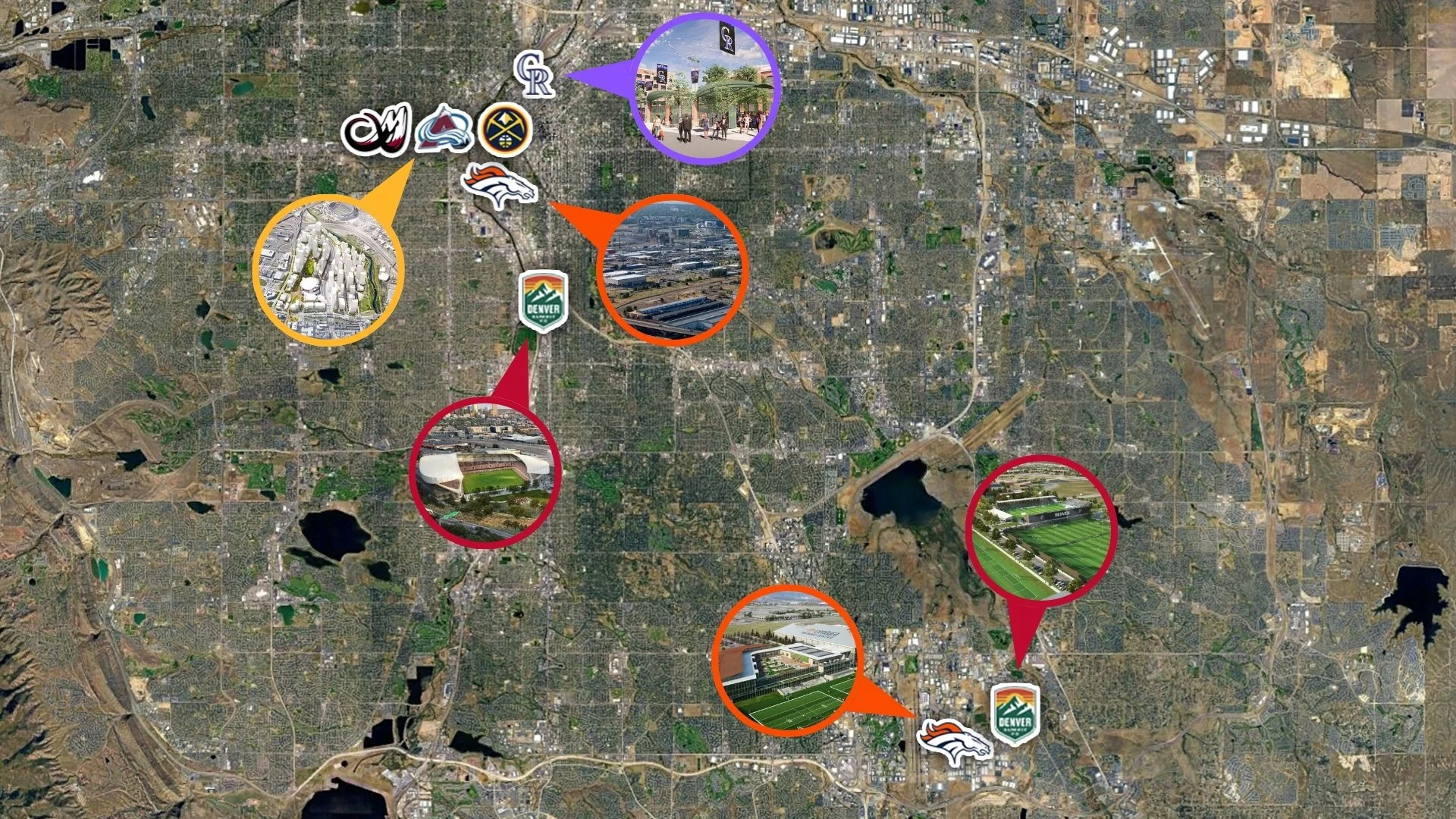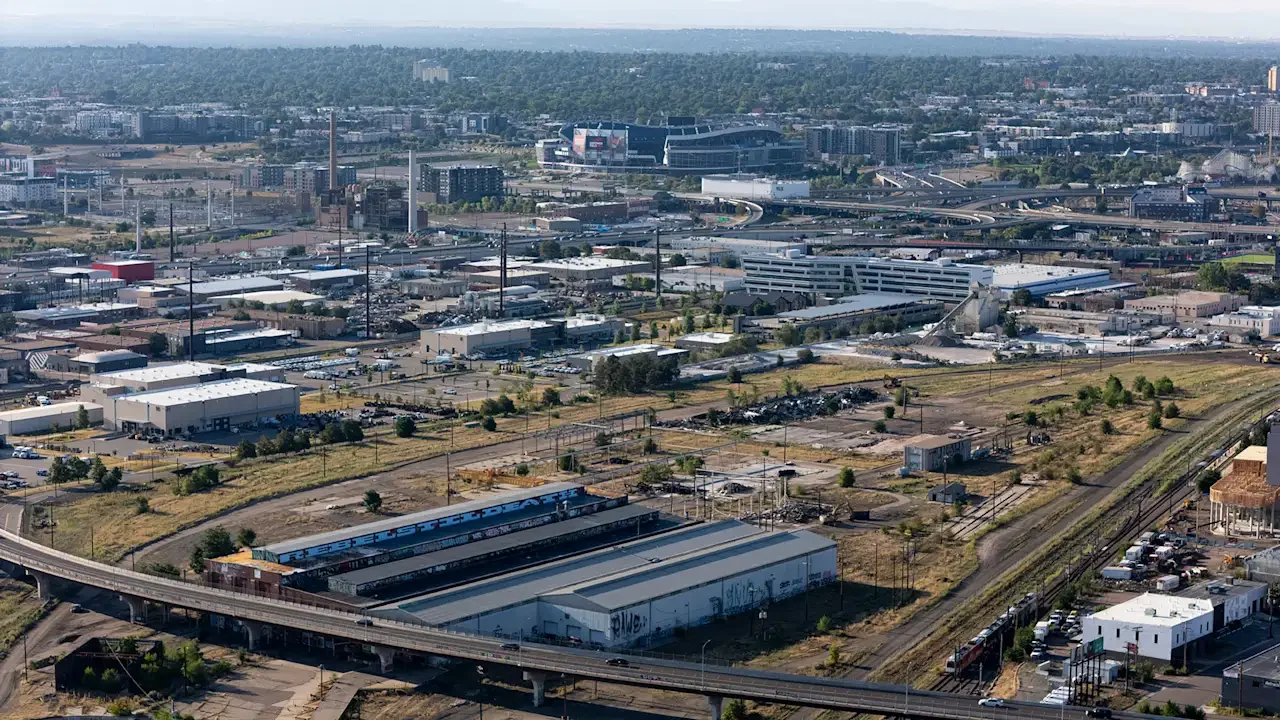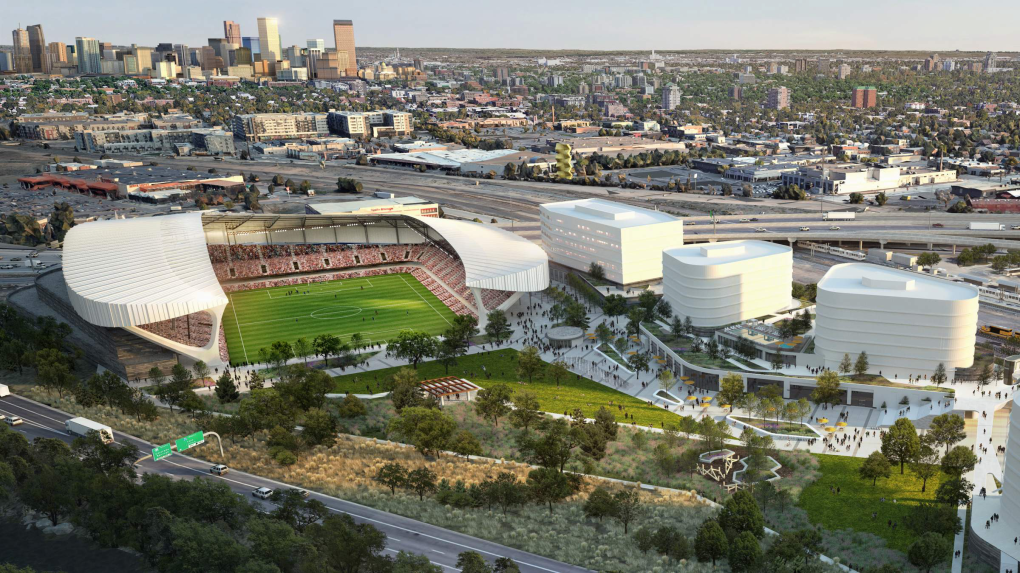Inside Denver’s Sports Redevelopment Boom: Six Projects Changing the Area
DENVER METRO AREA – Denver’s next wave of growth isn’t just about new housing and transit, it’s also being driven by major investments in sports and entertainment districts. From large-scale stadium plans to redevelopment around existing venues, nearly every corner of the city is seeing activity tied to the teams that define it.
Whether you’ve lived here for years or just arrived, these six projects show how professional sports are helping reshape the city’s urban landscape and expand its downtown footprint.nd of office-to-housing redevelopments.
Ball Arena Redevelopment in Downtown Denver
Kroenke Sports & Entertainment (KSE) has launched an ambitious redevelopment of the 55-acre Ball Arena campus, aiming to transform the surrounding parking lots into a dense, mixed-use neighborhood. The approved master plan calls for 10 to 12 million square feet of office, housing, retail, and entertainment uses; including up to 6,000 residential units, a hotel, public parks, and a new performance venue.
The City Council has voted to approve rezoning and development guidelines, and Phase 1A is hoping to break ground around 2026, with phased construction stretching possibly through 2050. Among the proposed first elements are two residential towers totaling roughly 300 units, a 13-story hotel, and a performance venue of about 173,000 square feet, all built over shared underground parking. KSE has also acquired additional parcels nearby, consolidating ownership to support a unified long-term plan that will connect the site to the Auraria campus and Cherry Creek Trail.
Estimated Cost: Multi-phase redevelopment valued in the billions, with initial phases expected to exceed $1 billion in private investment.
Photo Sourced from Ball Arena Concept Plan
New Broncos Stadium at Burnham Yard
In September 2025, the Broncos, the City of Denver, and the State designated Burnham Yard, a 58-acre former rail site southwest of downtown, as the preferred location for their next stadium and mixed-use district.
The project will feature a privately financed, retractable-roof stadium surrounded by a new entertainment district with restaurants, hotels, housing, and public plazas. Early estimates suggest the full buildout could exceed $4 billion in private investment, making it one of the most significant developments in Denver’s modern history.
The Broncos are targeting a 2031 opening, coinciding with the end of their current lease at Empower Field. While the stadium itself will be privately funded, the city and state are expected to support nearby infrastructure such as roads, bridges, and transit connections.
Estimated Cost: $4 billion+ privately funded development
Photo by Gabriel Christus / Denver Broncos / 2025 Denver Broncos
Broncos Training Facility in Centennial
The Denver Broncos are currently constructing a new state-of-the-art training facility and headquarters on their existing campus in Centennial. The project, named Broncos Park Powered by CommonSpirit, will replace the team’s aging complex with a larger, more modern facility designed to centralize both football operations and administrative offices under one roof.
Construction began in 2024 and is on track for completion by May 2026. Once operational, the team will demolish the existing 1990s-era training center. The project represents a $175 million private investment, funded entirely by the Walton-Penner Family Ownership Group.
More than just a headquarters, the new facility is designed to serve as a long-term community anchor, offering expanded fan amenities during training camp and setting a new architectural standard for NFL practice facilities.
Estimated Cost: $175 million, fully privately funded by the Walton-Penner Family Ownership Group.
Photo Sourced from Denver Broncos / HOK
Denver Summit’s NWSL Stadium at Broadway Station
Denver’s newly awarded NWSL franchise is planning a 14,500-seat, purpose-built stadium in the Santa Fe Yards area near Broadway Station, set to open in 2028. The stadium will anchor one of the city’s most significant redevelopment corridors, the multi-phase Broadway Station project, which is transforming former RTD and rail parcels into a new urban district featuring housing, offices, retail, and public spaces.
The NWSL stadium will sit at the northwest edge of this district, which will be eventually connected to a larger entertainment area and public transit. This location ties the team’s long-term home to a growing transit-oriented neighborhood that will eventually include thousands of residents and new commercial activity.
The project will be privately funded by the ownership group, with the City of Denver committing up to $70 million for land acquisition and infrastructure improvements to support the surrounding area, including new roadways, utilities, and public realm upgrades. Officials estimate the stadium’s total cost between $150 million and $200 million, making it one of the most significant sports investments south of downtown in recent decades.
Estimated Cost: $150–200 million (stadium)
City Investment: $70 million (land + infrastructure)
Photo Sourced from Denver Summit
Denver Summit’s Temporary Stadium & Performance Center in Centennial
Construction is underway on the CommonSpirit Performance Center, the new training and operations home for Denver Summit FC, Colorado’s National Women’s Soccer League franchise. The facility anchors a 43-acre campus in Centennial, which will also include a 12,000-seat temporary stadium where the team will play its inaugural seasons in 2026 and 2027 while the permanent Denver Summit Stadium near Broadway Station is completed.
Designed by Populous and managed by CAA ICON, the 20,000-square-foot performance center is tailored specifically for elite women’s athletes. It will feature eight full-size soccer fields, recovery and performance technology, private locker facilities, and dedicated spaces for team dining, family support, and wellness. The complex also incorporates strength and conditioning areas, sports science labs, and administrative offices, all intended to create one integrated, high-performance hub for the club.
The broader Centennial campus is being developed in partnership with the City of Centennial and the Cherry Creek School District, designed with long-term flexibility in mind to accommodate future community use and expansion.
Estimated Cost: Not disclosed (privately funded)
Photo Sourced from Denver Summit
Rockies East Plaza Redevelopment in the Ballpark District
The Rockies East Plaza is the next phase in the continued evolution of the Ballpark District, expanding the fan experience beyond the gates of Coors Field. Located along Blake Street, the project will convert underutilized space east of the stadium into a pedestrian-oriented public plaza designed for year-round activation.
The new plaza will feature landscaping, shaded seating areas, and flexible open space for live music, markets, and community events. It will also create a stronger physical connection between Coors Field, McGregor Square, and the surrounding retail corridors in Lower Downtown.
Led by the Colorado Rockies in partnership with Stantec, the project builds on the design principles established with McGregor Square, emphasizing walkability, visibility, and integration with the surrounding neighborhood. Construction documents are currently under review by the City of Denver, with work expected to begin after the 2025 MLB season to limit disruption during home games.
Estimated Cost: Not disclosed (team-funded capital improvement project)
Photos Sourced from Rockies East Plaza Application
A New Era for Sports and Urban Growth
Across Denver, sports are becoming a major catalyst for redevelopment and investment, reshaping neighborhoods, influencing infrastructure, and redefining how fans and residents experience the city. From the multi-billion-dollar Ball Arena District and the Broncos’ new stadium at Burnham Yard to the Denver Summit’s dual-campus expansion and the Rockies East Plaza, these projects represent more than upgrades to game-day experiences, they mark a shift toward fully integrated sports districts built around housing, hospitality, and community access.
Together, they form a new layer of Denver’s growth story: one where stadiums double as anchors for urban neighborhoods, training facilities become year-round community assets, and sports investment continues to drive civic momentum well beyond the scoreboard.
As each of these developments takes shape, they collectively signal what’s next for the Mile High City, a future where Denver’s passion for sports and its vision for urban renewal move forward on the same field.
All project information was sourced from publicly available site plans, renderings, and permitting documents.
See more behind the build on Denver’s greatest construction projects
Get a deeper dive on the who, what, when and why behind the city’s greatest construction projects with our premium member content.
Interested in sponsorship? Learn more about our sponsors and how to get involved.
All project information was sourced from publicly available site plans, renderings, and permitting documents.










9 minute read • A new Denver startup wants to rethink how homes can be sold by turning the process into a legally structured sweepstakes. We sat down with FulHouse co-founder Jason to understand how the model works, how they’re keeping it compliant, and what safeguards are in place to build trust.